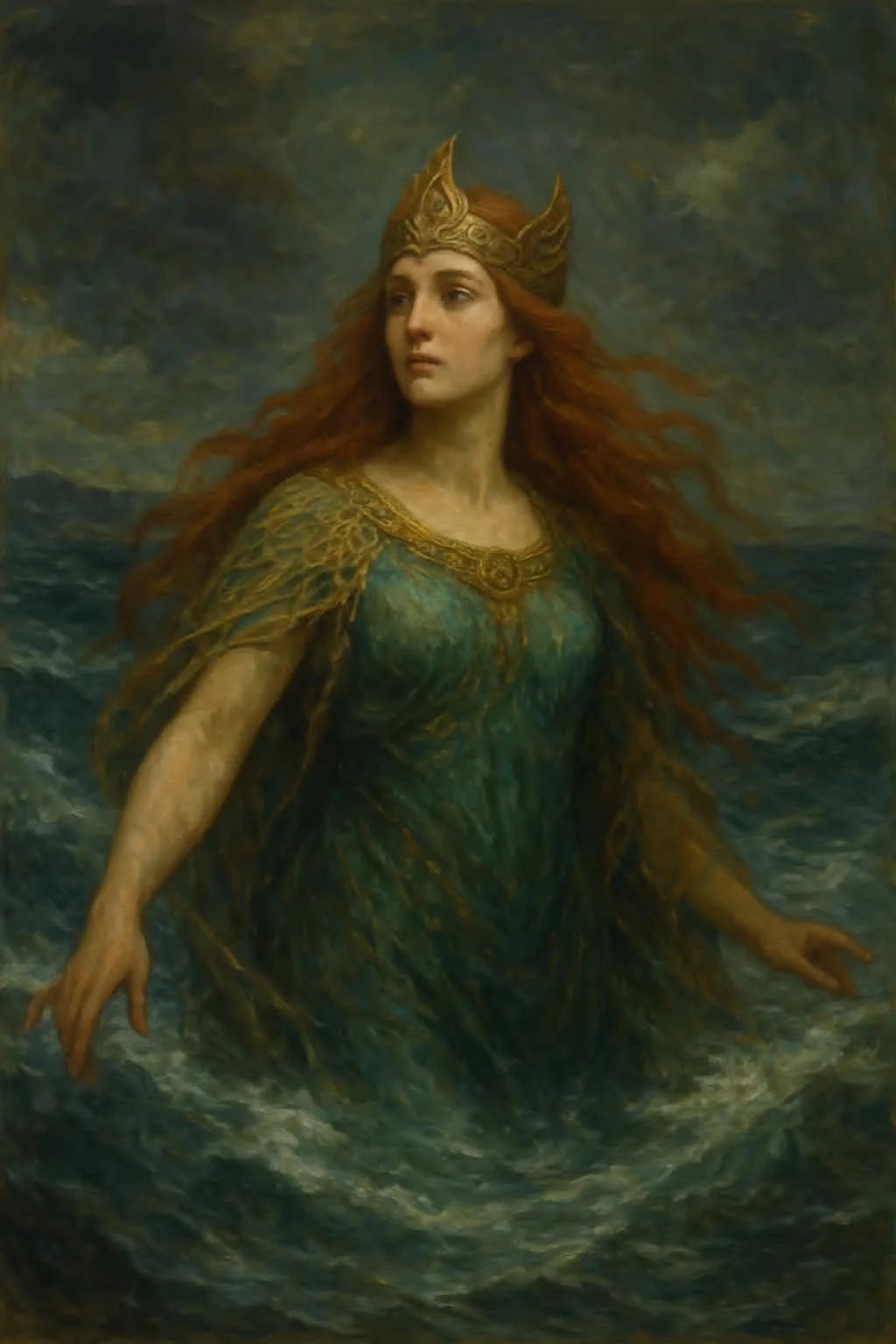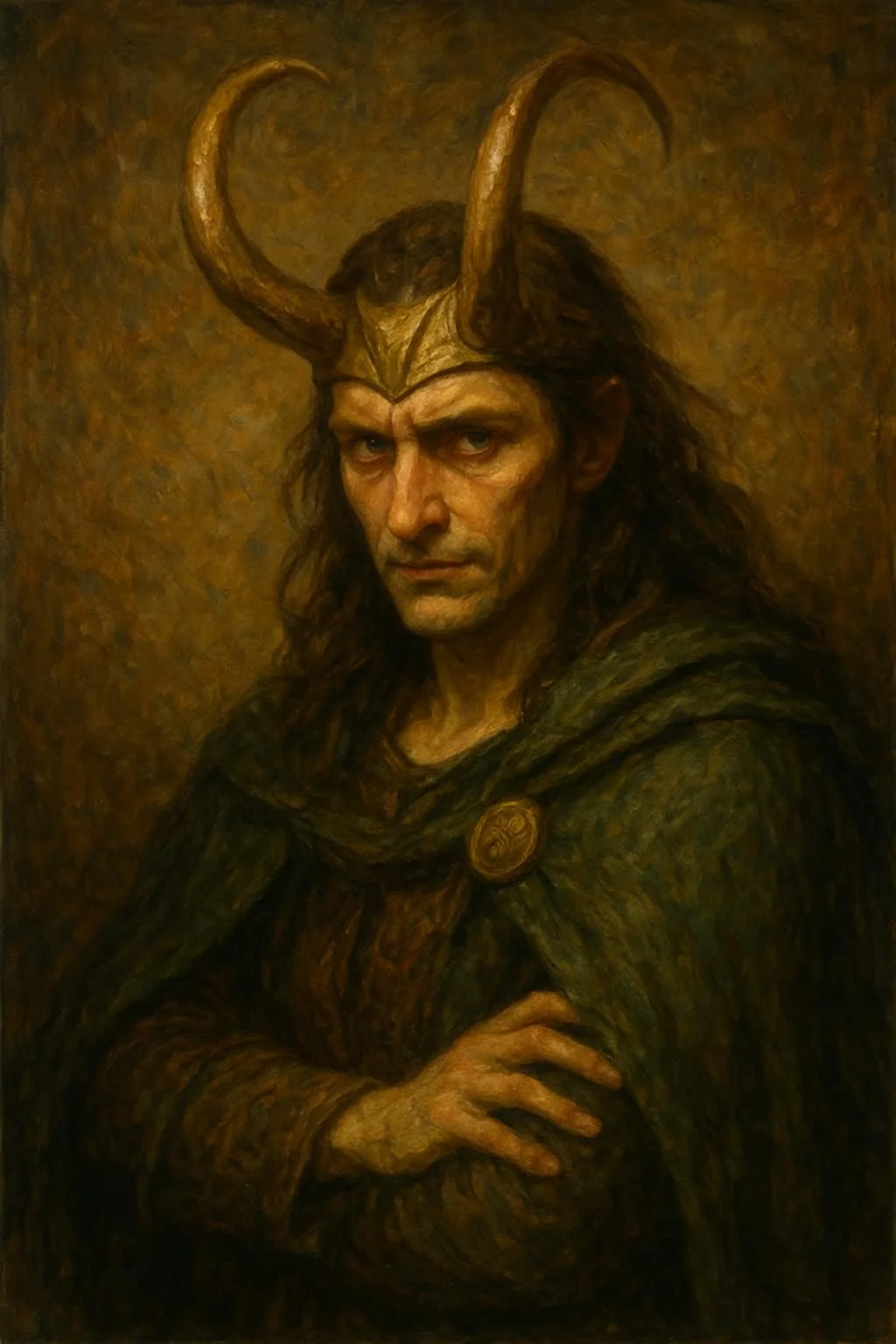
The lay of Rig (Story Form)
The Lay of Ríg tells how the god Heimdall (walking the earth in mortal form as Ríg) shaped the very fabric of human society. Through his visits to three households, he brought into being the ancestors of slaves, freemen, and nobles, binding all people to a shared divine origin.
It is not a tale of war or prophecy, but of creation and connection - a myth that reminds us that strength, skill, and wisdom each have their sacred place in the world.

Seiðr Craft - Chapter 3: Þolinmæði - Patience & Discipline
In seiðr, nothing is gained through haste. The old paths move at the pace of roots and rivers, not lightning. Þolinmæði (patience) is not quiet suffering, but sacred endurance: the willingness to keep returning to the work even when the gods are silent and the visions do not come.
Through Odin’s nine nights upon Yggdrasil, through Freyja’s long teaching of seiðr, the lore shows that power is not seized - it is cultivated through rhythm, repetition, and the slow shaping of the soul.
This lesson calls the practitioner to honour stillness, to embrace the silence between moments, and to learn that true mastery is not in commanding the unseen, but in remaining — steadfast as the tree, calm as the deep earth below it.

What Is Hamingja? The Spirit of Luck, Honour, and Ancestral Power
In the old Norse and Germanic world, luck was not seen as random. It was a living force called Hamingja — the spirit of luck, honour, and ancestral power. Hamingja flowed through the bloodlines of families, carried by the deeds of the living and the blessings of the dead.
Those who lived with courage, truth, and generosity strengthened their Hamingja, weaving fortune into their lives and the lives of their kin. Those who acted without honour weakened it, breaking the flow of luck and harmony.
To understand Hamingja is to see that luck and fate are not gifts or punishments — they are the reflection of one’s spirit. Through honour, courage, and right action, you do not escape your destiny — you shape it.

Rán: The Sea’s Embrace and Terror
Beneath the waves, where silence turns to hunger, dwells Rán - the Norse goddess of the sea’s embrace and terror. With her shining net, she gathers the drowned, holding them in her cold but certain arms.
Rán is not mercy, nor cruelty - she is truth. The sea gives and the sea takes, and every voyage is sailed under her shadow. To the Norse, she was both feared and honoured, the dark mirror of the ocean’s depth and fate’s inevitability.
Her net is more than a weapon — it is wyrd itself, weaving every life and loss into the vast tapestry of the sea. Through her, we remember that every surrender, every ending, and every storm is part of a larger design.
To face Rán is to face the deep: to accept what we cannot control, to live fiercely even knowing the tide will one day claim us. 🌊

Helheim: Realm of the Dead
In the shadowed depths beneath the roots of Yggdrasil lies Helheim, the realm of the forgotten dead. It is not a place of torment, but of stillness - a hall of silence where those not chosen by gods or heroes find their rest.
Here, the goddess Hel, half living and half dead, keeps watch over countless souls who fade quietly from memory. There is no fire, no feast, no battle-song — only the whisper of what was.
To the Norse, Helheim was not a punishment but a truth. It reminded them that most lives end not in glory, but in quiet endurance — and that even in silence, every life still matters. In this cold, reflective realm lies a profound lesson: that the unremembered are not lost, and that death, like winter, is a pause before return.

Erik the Red: The Outlaw Who Forged a World from Exile
In the old North, where fire met ice and exile was often a death sentence, one man turned banishment into legend. Erik the Red, the fierce and fiery outlaw, was cast out of every land he called home - yet he built one of his own. From Norway to Iceland and finally to Greenland, Erik’s fury became his fire, his exile became his forge, and from both he created a world that would outlast his name.
His story is not only one of discovery and defiance, but of vision, endurance, and the unbreakable will of a man who refused to kneel before fate. In his saga lies a timeless truth — that even in exile, the spirit of creation burns brightest.

What Is Wyrd? (The Web of Fate)
In the old faith of the Norse and Germanic peoples, fate was not a straight line — it was a web. Known as Wyrd, this vast and living pattern connects all beings, past and present, through every choice, thought, and deed. Wyrd is not something that controls us; it is something we help weave each day through our actions and our honour.
To understand Wyrd is to understand that life is not random — it is meaningful. Every thread you spin adds to the great tapestry of becoming. The gods, the ancestors, and we ourselves are bound within this web, shaping and being shaped by it. This is the old wisdom of the North — that fate and responsibility are one and the same.

How to Bless and Protect Your Home (Frigg’s Hearth Ritual)
Discover the ancient Norse way to bless and protect your home through Frigg’s Hearth Ritual — a practice of peace, honour, and connection with the goddess Frigg, Queen of Asgard. Rooted in the old traditions of the North, this simple and mindful ceremony invites the warmth of the hearth, the strength of the ancestors, and the protection of the land spirits into your household. Learn how to prepare sacred offerings, invoke Frigg’s presence, and weave harmony and courage into the fabric of your daily life.

Seiðr craft - Chapter 2: Virðing - Respect
Seiðr Craft – Chapter 2: Virðing (Respect) explores the heart of Norse magic through the ancient principle of virðing — the deep respect that binds all things in the web of being. Before the chants, before the visions, comes honour: to gods, to land, to ancestors, and to oneself.
Through stories from the sagas, lessons of reverence, and modern practices, this chapter reveals how seiðr is more than ritual — it is relationship. It teaches that power without respect becomes chaos, and that every act of magic begins with humility. When we honour what sustains us, our craft grows clear, steady, and alive.
This is a guide to walking the path of the völva with integrity, rooted in frith, woven into wyrd.

The Lay of Hyndla (In Story Form)
In the cold stillness of night, beneath a sky alive with stars, the goddess Freyja rides her golden-bristled boar, Hildisvíni, to the mountain cave of Hyndla, an ancient giantess who guards the secrets of blood and fate.
Freyja’s mortal follower, Óttar the Young, has staked his honour and inheritance on his forgotten lineage. To help him, Freyja seeks Hyndla’s wisdom — but the old seeress demands truth for truth and speaks the names of gods, kings, and heroes with a voice that shakes the stones.
As the cave fills with the echoes of ancient bloodlines — from Sigurðr the Dragon-Slayer to Haraldr Battle-Tooth — the goddess reveals that memory itself is magic, and that to know one’s ancestors is to awaken their power.
A story of ancestry, divine guidance, and the sacred weight of remembrance, The Lay of Hyndla bridges the mortal and the mythic — where every name spoken is a spark of the old world reborn.

Vetrnætr (Winter Nights): Origins, Meaning & How to Observe It Today
Vetrnætr — literally “winter nights” in Old Norse — was a key seasonal festival among medieval Scandinavian peoples, marking the shift into winter. It included feasts, ritual offerings to gods and land-spirits, and honouring ancestors. Some of the surviving saga accounts are strongly shaped by Christian-influenced authorship, so modern practitioners adapt what feels authentic. This blog explains Vetrnætr’s seasonal meaning, its mythic and ritual roots, and suggests respectful, meaningful ways to observe it today.

Frigg: The All-Mother, Weaver of Fates
Frigg is the unseen strength of the Norse cosmos — queen, mother, and silent knower of all fates. She weaves the threads that bind gods and mortals, shaping the world through patience, love, and foresight. From her hall of Fensalir, she watches destiny unfold, her silence as powerful as Odin’s wisdom or Thor’s hammer. In her story, we find the truth that endurance is its own kind of power — that to hold the world together, one need not roar, but weave.

Hyndluljóð - The Lay of Hyndla
Hidden among the verses of the Poetic Edda lies one of Norse mythology’s quietest treasures — Hyndluljóð, The Lay of Hyndla. It is not a tale of war or prophecy, but of memory, ancestry, and divine revelation. Here, the goddess Freyja rides beneath the northern stars with her mortal companion Óttar, seeking the wisdom of the giantess Hyndla, keeper of forgotten bloodlines and sacred truths.
Through their dialogue, we glimpse a world where to name one’s ancestors was to awaken their power, where genealogy was magic, and remembrance a sacred act. Hyndluljóð bridges gods and mortals, history and myth, teaching that the past is never gone — only waiting to be spoken back into life.
Forgotten by many, this poem remains one of the Edda’s most profound meditations on identity, belonging, and the divine roots of memory.

Niflheim: Realm of Mist and Ice
Before there was fire, there was mist. Niflheim, the frozen world of Norse myth, lies at the edge of creation — a realm of silence, frost, and shadow where death and life intertwine. From its rivers came the first giants; beneath its mists dwell the forgotten dead. More than a land of endings, Niflheim is the cold patience that balances fire, the quiet breath between creation and destruction. To understand it is to understand the stillness that holds the cosmos together.

What is Seiðr?
Among the many mysteries of the Norse world, none burns more brightly — or more enigmatically — than seiðr. Ancient, fluid, and powerful, seiðr was the magic of the gods and the wise — a sacred art of weaving fate, calling spirits, and walking between worlds. Practised by goddesses like Freyja and Frigg, and mastered by Óðinn himself, seiðr was both honoured and feared - a craft that crossed the lines between gender, power, and the visible world.
To understand seiðr is to glimpse the spiritual heart of Norse belief: a world alive with spirits, woven with destiny, and bound by respect. It is not a lost art, but a living conversation — between will and wyrd, reverence and power, the seen and the unseen.

Loki: The Flame Between Worlds
Loki: the flame in the dark, the spark of change, the whisper that shatters silence. Neither good nor evil, this restless god moves between worlds — shapeshifter, trickster, and bringer of both ruin and renewal.
In this in-depth exploration of Norse mythology, we trace Loki from the ancient Eddas to the fires of Ragnarök and beyond. You’ll meet the sly companion of Odin, the maker of miracles and monsters, the bound god beneath the earth, and the unbound flame who brings about the world’s end — and its rebirth.
Through myth, symbolism, and modern reflection, Loki: The Flame Between Worlds explores what the trickster teaches us today: that chaos is not the enemy of order, but its necessary partner.
Fire burns, but it also gives light. Loki reminds us that every ending is a beginning — and that the spark of change lives in all of us.

How to: Sumbel (Ritual Toasting and Oathing)
Sumbel, or sumbl in Old Norse, is one of the most powerful rituals of pre-Christian Scandinavia. More than a drinking feast, it was a sacred act where words carried weight, oaths were sworn, and the bonds of kinship and honour were strengthened before gods and ancestors. From the halls of Icelandic sagas to modern heathen gatherings, sumbel has endured as a living tradition. In this guide, we explore its history, sources, and meaning — and show you how to practise it today with respect and sincerity.

About: Oaths and Oathing in Norse Tradition
In the world of the Norse, words held power — none more so than the oath. Sworn before gods, ancestors, and community, an oath bound a person’s honour to fate itself. To keep one strengthened reputation and divine favour; to break one invited ruin, shame, and the wrath of the gods. This in-depth guide explores the history of Norse oathing, from temple rings and sumbel feasts to the laws of the thing and the lessons preserved in the sagas. Discover how sacred speech once shaped lives — and why it still matters for modern heathens today.

Seiðr craft - chapter 1: Introduction
Seiðr-craft is not a pastime or performance. It is an ancient Northern art that bends the will, pierces the veil, and weaves into wyrd itself. Before trance, vision, or rune-song comes something quieter but far more essential: learning how to stand — to ground, to centre, to take your place within the web of fate.
In this opening chapter, I share the foundations of the craft of seiðr. We look at spiritual gifts and growth paths, the chaos cycles that repeat until their lessons are learned, and the importance of aligning your hugr (spirit-mind) and hamingja (fortune, spiritual strength) before you attempt deeper work.
Most importantly, I introduce the Five Laws of Seiðr: Virðing (Respect), Þolinmæði (Patience), Mörk (Boundaries), Sannindi (Truth), and Ábyrgð (Responsibility). These are not restrictions, but alignments. They are the frame of the high-seat and the grain of the staff — the laws that hold your practice steady and safe.
This is the beginning of the staff-road. Without these roots, no branch can hold.

Types of Spiritual Gifts - A Complete Guide
Not all spiritual gifts arrive in the same form. Some burn quietly like embers, while others strike like storms. In Norse tradition, such gifts were never casual talents—they were rare burdens woven into wyrd itself, sacred responsibilities that shaped a life and demanded respect. This guide explores modern spiritual gifts—energy work, empathy, vision, song—and their echoes in ancient Northern practice, revealing how each must be carried with honour, patience, and discipline.

